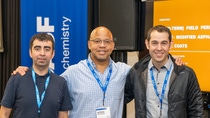Media
Unleashing the power of open innovation through intrapreneurship
A cross-functional team at BASF developed a customer-centric solution for the construction industry in under two years by utilizing agile methodology as well as internal and external partnerships.

When it comes to innovation, new products can often take several years to develop. In the chemical industry, every aspect of the product needs to be thoroughly analyzed, tested and supported by data before it can be launched to the market and sold to customers. These processes can often take up to five years or more and don’t always come to fruition.
This was the status quo until recently, when a team of BASF collaborators from Monomers North America, led by Market Development Specialist, Bernie Malonson, and Technical Services Manager, Brian Orr, were able to develop a customer-centric solution by incorporating an agile methodology and leveraging internal and external solutions for the construction industry in under two years.
Learn more about this significant accomplishment below.
Paving the way for innovation
Roads generally last between ten and 20 years before they need to be resurfaced. However, in the last 30 years, the concept of “pavement preservation" has become a great solution to expand the lifespan of roads and stop deterioration. They include a series of maintenance treatments every five or ten years to maintain a functional driving surface, and offer significant benefits:
- Every dollar spent on pavement preservation saves approximately $7 in road construction spend.
- It can cut repair, rehabilitation and reconstruction times significantly.
- It avoids associated traffic disruptions.
BASF has several customers working in road construction and preservation that require and successfully use specific products such as BASF’s Butonal polymer emulsions to complete these treatments. Among their many uses, Butonal emulsions can be sprayed on the surface of the road, on top of which stone aggregates are later added and compacted to create the driving surface.
By recognizing continuing needs in the market for new innovative solutions and future requests from current and future BASF customers, Bernie Malonson and the asphalt research team in Monomers led by Brian Orr have identified additional areas of opportunity for BASF to fill in the paving market.
In Malonson’s words, “We know prospective customers continue to ask the monomers team about pavement preservation applications using reactive-isocyanate-based modifiers, and we understand many of their market challenges. So, we adopted a market-based approach, which becomes the proxy for the needs of the customer. By understanding the market, we can then collaborate with research partners and advocates.”

Angelo Filonzi, Research Associate from the University of Texas, Austin, Bernie Malonson, Market Development Specialist from BASF, and Thomas Holcombe, BASF’s Scouting & Partnerships Team Leader and Head of NORA.
The solution
B2Last® is a high-performance, sustainable reactive isocyanate-based bitumen additive that can make roads more durable while significantly reducing CO2 emissions. B2Last® enables a high use of recycled asphalt content and allows less energy to be used to heat the bitumen. This was the perfect starting point for developing a new emulsion, and it’s exactly where researchers began.
"B2Last® is a very adaptive modifier that allows for the creation of more functional and usable asphalt emulsion. We used B2Last® to create a product that will increase the retention of stone chips when used in conjunction with BASF’s Butonal styrene butadiene rubber (SBR)," explains Brian Orr, Technical Service Manager for Rigid Isocyanates – Asphalt.
After completing the research and development in-house in collaboration with BASF Dispersions & Resins experts, BASF was able to successfully apply and publish a patent for B2Last®-based emulsions. By teaming up with the North American Open Research Alliance (NORA), they were able to get funding and the means to test the formulation externally.
As a proximity partner of NORA, the University of Texas at Austin (UT Austin) was the perfect choice for conducting external research. The team was able to achieve product validation and gain scientific results that advance the technology – working with some of the best minds in academia and utilizing assets already in place, for a very effective partnership.
Once the formulation was validated by BASF and UT Austin, it was time for the trial. Through UT Austin and the BASF Dispersion Americas division, the team was able to partner with customer Ergon Asphalt and Emulsions and Williamson County in Texas to conduct a long-term field performance trial of the emulsion and apply the solution over a three-mile road.
Witnessing the remarkable collaboration between two of BASF's businesses, the University of Texas at Austin and our customer Ergon, fills me with gratitude. This partnership not only accelerates our product development cycle but also enables us to effectively create chemistry for a sustainable future.
“Partnering with customers is very important and beneficial to BASF. Our customers know the transportation agencies, and the specified performance of the products they manufacture. They provide very important feedback and critical evaluation to our development teams and help us pull the new products into the market,” explains Arlis Kadrmas, Expert Technical Specialist from the Construction and Fiber Bonding segment in Dispersions Americas.
As one of BASF's CORE values, entrepreneurship was the basis for pushing this entire model forward.
The road ahead
The agile product development system provides an advantage much needed in today’s business environment. Often, within big companies, processes work in a linear timeline, where a new step in the process is only initiated once the previous step is completed.
However, by applying an agile method, such as the one implemented by the collaboration of BASF’s central research division, and both the North American Monomers and Dispersions divisions, multiple steps could be worked in parallel to produce results in shorter periods of time.
Perfect is the enemy of good. It wasn't a perfect process, but sometimes with innovation, when you start brainstorming, it's not always clean. There are learnings that we can now incorporate, without necessarily compromising speed.
Now that the initial road has been paved, this same agile system can be applied to other opportunities across all regions, amplifying its impact. In Malonson’s words, “Because BASF has a global footprint and can leverage resources across the globe, the data that we are generating now can be used by others, for example, colleagues in South America or India who can now use this data to introduce similar customer solutions.”
To learn more about our products, visit the BASF Monomers webpage.
Published on May 2, 2024 by Mariana Licio.
For media inquiries or to repurpose this article, please contact Lisa Brown.



